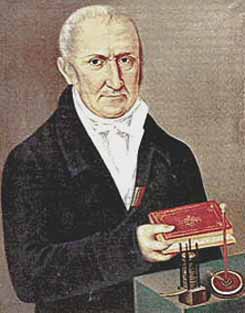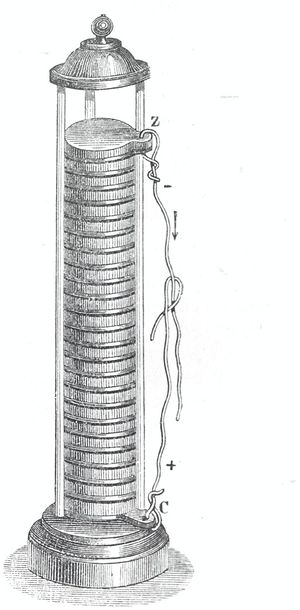Alessandro Volta: Difference between revisions
No edit summary |
No edit summary |
||
| (7 intermediate revisions by 2 users not shown) | |||
| Line 1: | Line 1: | ||
== Alessandro Volta | {{Biography | ||
|Image=Alessandro Volta.jpg | |||
|Caption=Alessandro Volta | |||
|Birthdate=1745/02/18 | |||
|Death date=1827/03/05 | |||
|Fields of study=Batteries | |||
}} | |||
[[Image:0155 Voltaic Pile.jpg|thumb|right|Voltaic Pile]] | |||
Volta invented the [[Voltaic Pile|Voltaic pile]] in 1799. The principles of the Voltaic pile, that is using a chemical reaction to create energy, have been used in batteries ever since. | |||
Regarded as one of the greatest scientists of his time, Alessandro Volta’s two major contributions to the history of electro-technology were the voltaic cell and his own name. Volta publicly demonstrated the voltaic pile, later known as the battery, in 1799. This was the first continuous reproducible source of electrical current. His surname, Volta, was abbreviated to become the unit of electromotive force—the volt (abbreviated as V). | |||
[[ | Alessandro Volta was born to a noble and wealthy family on 18 February 1745 in Como, Italy. He began the experiments that would lead to the invention of the battery after fellow Italian [[Luigi Galvani|Luigi Galvani]] asserted that animal tissue (in this case, dead frogs’ legs) generated “animal electricity.” Volta doubted that animal tissue was a source of electricity and by careful and thorough experimentation proved that animal tissue was the conductor, not the source, of electricity in Galvani’s experiments. | ||
Like many great inventors and scientists, Volta was an extremely driven person. When engrossed in experiments, the only way his manservant could convince him to change his clothes was by distracting him with scientific questions while helping him dress. This dedication paid off both in terms of inventions and notoriety. Volta was something of a celebrity during his time and his fans included Napoleon, who made him a count in 1801. | |||
Volta died on 5 March 1827 at the age of 82. | |||
== Further Reading == | |||
[[Voltaic Pile|Voltaic Pile]] | |||
[[Milestones:Volta's Electrical Battery Invention, 1799|Milestone: Volta's Electrical Battery Invention, 1799]] | |||
Volta | {{DEFAULTSORT:Volta}} | ||
[[Category: | [[Category:People and organizations]] | ||
[[Category:Inventors]] | |||
[[Category:Energy]] | |||
[[Category:Scientists]] | |||
[[Category:Electrochemical devices & processes]] | |||
[[Category:Batteries]] | |||
[[Category:Biomedical engineering]] | |||
[[Category:Bioelectrochemistry]] | |||
Latest revision as of 19:25, 3 April 2023
- Birthdate
- 1745/02/18
- Death date
- 1827/03/05
- Fields of study
- Batteries
Biography
Volta invented the Voltaic pile in 1799. The principles of the Voltaic pile, that is using a chemical reaction to create energy, have been used in batteries ever since.
Regarded as one of the greatest scientists of his time, Alessandro Volta’s two major contributions to the history of electro-technology were the voltaic cell and his own name. Volta publicly demonstrated the voltaic pile, later known as the battery, in 1799. This was the first continuous reproducible source of electrical current. His surname, Volta, was abbreviated to become the unit of electromotive force—the volt (abbreviated as V).
Alessandro Volta was born to a noble and wealthy family on 18 February 1745 in Como, Italy. He began the experiments that would lead to the invention of the battery after fellow Italian Luigi Galvani asserted that animal tissue (in this case, dead frogs’ legs) generated “animal electricity.” Volta doubted that animal tissue was a source of electricity and by careful and thorough experimentation proved that animal tissue was the conductor, not the source, of electricity in Galvani’s experiments.
Like many great inventors and scientists, Volta was an extremely driven person. When engrossed in experiments, the only way his manservant could convince him to change his clothes was by distracting him with scientific questions while helping him dress. This dedication paid off both in terms of inventions and notoriety. Volta was something of a celebrity during his time and his fans included Napoleon, who made him a count in 1801.
Volta died on 5 March 1827 at the age of 82.

